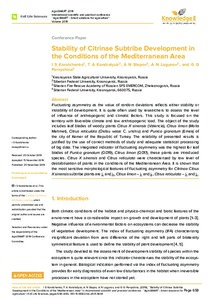Stability of Citrinae Subtribe Development in the Conditions of the Mediterranean Area
Скачать файл:
URI (для ссылок/цитирований):
https://publons.com/publon/30106414/https://elib.sfu-kras.ru/handle/2311/143393
Автор:
Коротченко, И. С.
Кондратюк, Т. А.
Слепов, А. Н.
Лагунов, А. Н.
Первышина, Г. Г.
Коллективный автор:
Торгово-экономический институт
Кафедра технологии и организации общественного питания
Дата:
2019-11Журнал:
KnE LIFE SCIENCEКвартиль журнала в Web of Science:
без квартиляБиблиографическое описание:
Коротченко, И. С. Stability of Citrinae Subtribe Development in the Conditions of the Mediterranean Area [Текст] / И. С. Коротченко, Т. А. Кондратюк, А. Н. Слепов, А. Н. Лагунов, Г. Г. Первышина // KnE LIFE SCIENCE: INTERNATIONAL CONFERENCE ON NATURAL RESOURCES AND LIFE SCIENCE. — 2019. — С. 659-665Аннотация:
Fluctuating asymmetry as the value of random deviations reflects either stability or
instability of development. It is quite often used by researchers to assess the level
of influence of anthropogenic and climatic factors. This study is focused on the
territory with favorable climate and low anthropogenic load. The object of the study
includes leaf blades of woody plants Citrus X sinensis (Valencia), Citrus limon (Molla
Mehmet), Citrus reticulata (Okitsu wase C. unshiu) and Punica granatum (Emek) of
the city of Kemer of the Republic of Turkey. The reliability of presented results is
justified by the use of correct methods of study and adequate statistical processing
of big data. The integrated indicator of fluctuating asymmetry was the highest for leaf
blades of Punica granatum (0.019), Citrus limon (0.017), these plants are introduced
species. Citrus X sinensis and Citrus reticulata were characterized by low level of
destabilization of plants in the conditions of the Mediterranean Area. It is shown that
the most sensitive morphological features of fluctuating asymmetry for Citrinae Citrus
X sinensis subtribe plants are j4 and j5, Cítrus límon -- j2 and j5, Citrus reticulata -- j3 and j4.

